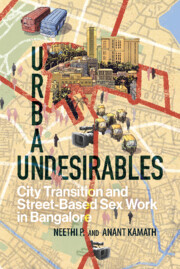5 - Upheaval
Published online by Cambridge University Press: 30 June 2022
Summary
Bangalore city has been continuously and repeatedly reimagined for centuries, but the pace of wholesale reconfiguration over the last two decades, of what and who Bangalore is, has been matchless. Janaki Nair has shown how even social movements in Bangalore have been mostly gentrified, which she has interpreted articulately as an ‘ideology of beauty’, which we encapsulate here. Crusades against the prevention of the ‘misuse’ of ‘public’ spaces by ‘anti-social elements’ have enjoyed the full support of the middle- and upper-middle classes, and have been backed by the corporate sector, who wish to ‘rehabilitate’ the city's image as peaceful, air-conditioned and content, with their own upmarket concerns around image, aesthetics, planning, administration and environment. On aesthetic and environmental grounds, even bottom-up political rallies and strikes, struggles for civil or worker rights and protests by distressed economic groups were, over time, diverted from strategically effective locations, such as in front of the state legislature and in public parks, to designated plots some distance away so they could be hidden from view. Indubitably, this has been a textbook example of revanchism. These ‘concerned’ citizens and their protests put a spotlight on the core spaces in the city, spaces that were actually an axis for informal livelihoods which were seen as inconveniences or as anti-social (except if they catered to the recreational requirements of the comfortable and the affluent). There was little appreciation among these upmarket protestors that Bangalore's green spaces were not only Cubbon Park or Lalbagh, but in homes across every class and character in the city – be it expansive gardens within colonial bungalows in Langford Town or simply rows of potted plants in front of workers’ quarters and shanties around the old mills and markets of Bangalore, or in scores of lakes and tanks, wide trees on the streets or religious groves (all these described extensively in Harini Nagendra's aptly titled Nature in the City), which is what made Bangalore a garden city in a genuine sense. In fact, as Janaki Nair revealed in a telling anecdote, campaigners for aesthetics suggested at one point, in a spirit of high revanchism, that the ‘heterogeneous crowds’ who thronged the high court complex for their businesses should be forbidden to enter Cubbon Park that lies right beside it, lest they ruined its ‘elegance and beauty’.
- Type
- Chapter
- Information
- Urban UndesirablesCity Transition and Street-Based Sex Work in Bangalore, pp. 102 - 141Publisher: Cambridge University PressPrint publication year: 2022

